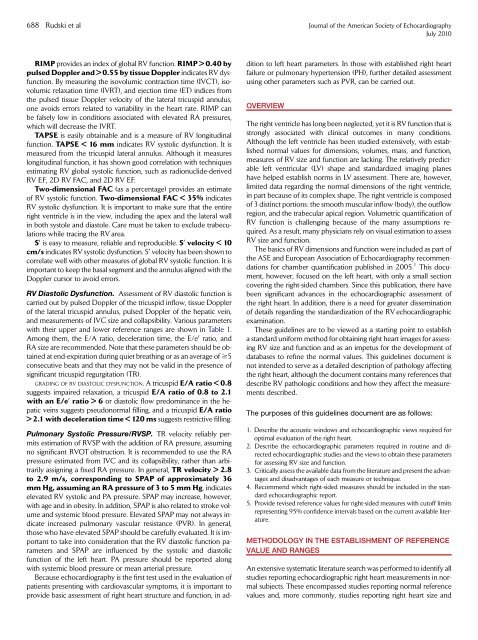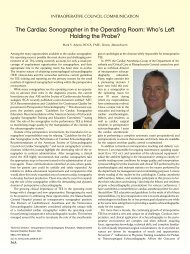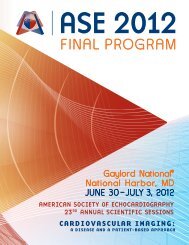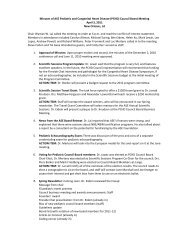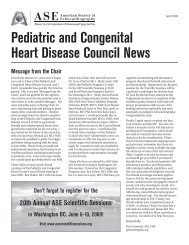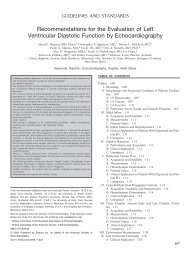Guidelines for the Echocardiographic Assessment of the Right Heart ...
Guidelines for the Echocardiographic Assessment of the Right Heart ...
Guidelines for the Echocardiographic Assessment of the Right Heart ...
Create successful ePaper yourself
Turn your PDF publications into a flip-book with our unique Google optimized e-Paper software.
688 Rudski et al Journal <strong>of</strong> <strong>the</strong> American Society <strong>of</strong> Echocardiography<br />
July 2010<br />
RIMP provides an index <strong>of</strong> global RV function. RIMP > 0.40 by<br />
pulsed Doppler and > 0.55 by tissue Doppler indicates RV dysfunction.<br />
By measuring <strong>the</strong> isovolumic contraction time (IVCT), isovolumic<br />
relaxation time (IVRT), and ejection time (ET) indices from<br />
<strong>the</strong> pulsed tissue Doppler velocity <strong>of</strong> <strong>the</strong> lateral tricuspid annulus,<br />
one avoids errors related to variability in <strong>the</strong> heart rate. RIMP can<br />
be falsely low in conditions associated with elevated RA pressures,<br />
which will decrease <strong>the</strong> IVRT.<br />
TAPSE is easily obtainable and is a measure <strong>of</strong> RV longitudinal<br />
function. TAPSE < 16 mm indicates RV systolic dysfunction. It is<br />
measured from <strong>the</strong> tricuspid lateral annulus. Although it measures<br />
longitudinal function, it has shown good correlation with techniques<br />
estimating RV global systolic function, such as radionuclide-derived<br />
RV EF, 2D RV FAC, and 2D RV EF.<br />
Two-dimensional FAC (as a percentage) provides an estimate<br />
<strong>of</strong> RV systolic function. Two-dimensional FAC < 35% indicates<br />
RV systolic dysfunction. It is important to make sure that <strong>the</strong> entire<br />
right ventricle is in <strong>the</strong> view, including <strong>the</strong> apex and <strong>the</strong> lateral wall<br />
in both systole and diastole. Care must be taken to exclude trabeculations<br />
while tracing <strong>the</strong> RV area.<br />
S 0 is easy to measure, reliable and reproducible. S 0 velocity < 10<br />
cm/s indicates RV systolic dysfunction. S 0 velocity has been shown to<br />
correlate well with o<strong>the</strong>r measures <strong>of</strong> global RV systolic function. It is<br />
important to keep <strong>the</strong> basal segment and <strong>the</strong> annulus aligned with <strong>the</strong><br />
Doppler cursor to avoid errors.<br />
RV Diastolic Dysfunction. <strong>Assessment</strong> <strong>of</strong> RV diastolic function is<br />
carried out by pulsed Doppler <strong>of</strong> <strong>the</strong> tricuspid inflow, tissue Doppler<br />
<strong>of</strong> <strong>the</strong> lateral tricuspid annulus, pulsed Doppler <strong>of</strong> <strong>the</strong> hepatic vein,<br />
and measurements <strong>of</strong> IVC size and collapsibility. Various parameters<br />
with <strong>the</strong>ir upper and lower reference ranges are shown in Table 1.<br />
Among <strong>the</strong>m, <strong>the</strong> E/A ratio, deceleration time, <strong>the</strong> E/e 0 ratio, and<br />
RA size are recommended. Note that <strong>the</strong>se parameters should be obtained<br />
at end-expiration during quiet breathing or as an average <strong>of</strong> $5<br />
consecutive beats and that <strong>the</strong>y may not be valid in <strong>the</strong> presence <strong>of</strong><br />
significant tricuspid regurgitation (TR).<br />
GRADING OF RV DIASTOLIC DYSFUNCTION. A tricuspid E/A ratio < 0.8<br />
suggests impaired relaxation, a tricuspid E/A ratio <strong>of</strong> 0.8 to 2.1<br />
with an E/e 0 ratio > 6 or diastolic flow predominance in <strong>the</strong> hepatic<br />
veins suggests pseudonormal filling, and a tricuspid E/A ratio<br />
> 2.1 with deceleration time < 120 ms suggests restrictive filling.<br />
Pulmonary Systolic Pressure/RVSP. TR velocity reliably permits<br />
estimation <strong>of</strong> RVSP with <strong>the</strong> addition <strong>of</strong> RA pressure, assuming<br />
no significant RVOT obstruction. It is recommended to use <strong>the</strong> RA<br />
pressure estimated from IVC and its collapsibility, ra<strong>the</strong>r than arbitrarily<br />
assigning a fixed RA pressure. In general, TR velocity > 2.8<br />
to 2.9 m/s, corresponding to SPAP <strong>of</strong> approximately 36<br />
mm Hg, assuming an RA pressure <strong>of</strong> 3 to 5 mm Hg, indicates<br />
elevated RV systolic and PA pressure. SPAP may increase, however,<br />
with age and in obesity. In addition, SPAP is also related to stroke volume<br />
and systemic blood pressure. Elevated SPAP may not always indicate<br />
increased pulmonary vascular resistance (PVR). In general,<br />
those who have elevated SPAP should be carefully evaluated. It is important<br />
to take into consideration that <strong>the</strong> RV diastolic function parameters<br />
and SPAP are influenced by <strong>the</strong> systolic and diastolic<br />
function <strong>of</strong> <strong>the</strong> left heart. PA pressure should be reported along<br />
with systemic blood pressure or mean arterial pressure.<br />
Because echocardiography is <strong>the</strong> first test used in <strong>the</strong> evaluation <strong>of</strong><br />
patients presenting with cardiovascular symptoms, it is important to<br />
provide basic assessment <strong>of</strong> right heart structure and function, in ad-<br />
dition to left heart parameters. In those with established right heart<br />
failure or pulmonary hypertension (PH), fur<strong>the</strong>r detailed assessment<br />
using o<strong>the</strong>r parameters such as PVR, can be carried out.<br />
OVERVIEW<br />
The right ventricle has long been neglected, yet it is RV function that is<br />
strongly associated with clinical outcomes in many conditions.<br />
Although <strong>the</strong> left ventricle has been studied extensively, with established<br />
normal values <strong>for</strong> dimensions, volumes, mass, and function,<br />
measures <strong>of</strong> RV size and function are lacking. The relatively predictable<br />
left ventricular (LV) shape and standardized imaging planes<br />
have helped establish norms in LV assessment. There are, however,<br />
limited data regarding <strong>the</strong> normal dimensions <strong>of</strong> <strong>the</strong> right ventricle,<br />
in part because <strong>of</strong> its complex shape. The right ventricle is composed<br />
<strong>of</strong> 3 distinct portions: <strong>the</strong> smooth muscular inflow (body), <strong>the</strong> outflow<br />
region, and <strong>the</strong> trabecular apical region. Volumetric quantification <strong>of</strong><br />
RV function is challenging because <strong>of</strong> <strong>the</strong> many assumptions required.<br />
As a result, many physicians rely on visual estimation to assess<br />
RV size and function.<br />
The basics <strong>of</strong> RV dimensions and function were included as part <strong>of</strong><br />
<strong>the</strong> ASE and European Association <strong>of</strong> Echocardiography recommendations<br />
<strong>for</strong> chamber quantification published in 2005. 1 This document,<br />
however, focused on <strong>the</strong> left heart, with only a small section<br />
covering <strong>the</strong> right-sided chambers. Since this publication, <strong>the</strong>re have<br />
been significant advances in <strong>the</strong> echocardiographic assessment <strong>of</strong><br />
<strong>the</strong> right heart. In addition, <strong>the</strong>re is a need <strong>for</strong> greater dissemination<br />
<strong>of</strong> details regarding <strong>the</strong> standardization <strong>of</strong> <strong>the</strong> RV echocardiographic<br />
examination.<br />
These guidelines are to be viewed as a starting point to establish<br />
a standard uni<strong>for</strong>m method <strong>for</strong> obtaining right heart images <strong>for</strong> assessing<br />
RV size and function and as an impetus <strong>for</strong> <strong>the</strong> development <strong>of</strong><br />
databases to refine <strong>the</strong> normal values. This guidelines document is<br />
not intended to serve as a detailed description <strong>of</strong> pathology affecting<br />
<strong>the</strong> right heart, although <strong>the</strong> document contains many references that<br />
describe RV pathologic conditions and how <strong>the</strong>y affect <strong>the</strong> measurements<br />
described.<br />
The purposes <strong>of</strong> this guidelines document are as follows:<br />
1. Describe <strong>the</strong> acoustic windows and echocardiographic views required <strong>for</strong><br />
optimal evaluation <strong>of</strong> <strong>the</strong> right heart.<br />
2. Describe <strong>the</strong> echocardiographic parameters required in routine and directed<br />
echocardiographic studies and <strong>the</strong> views to obtain <strong>the</strong>se parameters<br />
<strong>for</strong> assessing RV size and function.<br />
3. Critically assess <strong>the</strong> available data from <strong>the</strong> literature and present <strong>the</strong> advantages<br />
and disadvantages <strong>of</strong> each measure or technique.<br />
4. Recommend which right-sided measures should be included in <strong>the</strong> standard<br />
echocardiographic report.<br />
5. Provide revised reference values <strong>for</strong> right-sided measures with cut<strong>of</strong>f limits<br />
representing 95% confidence intervals based on <strong>the</strong> current available literature.<br />
METHODOLOGY IN THE ESTABLISHMENT OF REFERENCE<br />
VALUE AND RANGES<br />
An extensive systematic literature search was per<strong>for</strong>med to identify all<br />
studies reporting echocardiographic right heart measurements in normal<br />
subjects. These encompassed studies reporting normal reference<br />
values and, more commonly, studies reporting right heart size and


